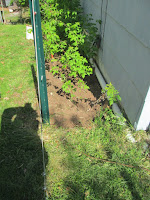Normally, the Gardeners' Holiday at the end of April and beginning of May is all about the asparagus, the only crop that's really producing at this time of year. But sadly, we're not getting much asparagus at the moment. The bed on the south side of the house has produced only a few ounces' worth, and the bed outside the fenced garden hasn't yielded a single spear big enough to harvest. Only a couple of the plants have sent up so much as a tiny frond.
Part of the problem, I guessed, was that there were too many weeds in the beds. Unfortunately, pulling them out by hand is a time-consuming process, and it's difficult to do without crawling into the bed itself and compressing the soil. And even if I'd spent the time and energy to do it, I suspected the weeds would have been back with a vengeance in a week or two. What the beds really needed, I thought, was a good layer of mulch to suppress the weeds.
So last weekend, we went off to the Belle Mead Co-Op to buy half a yard of their bulk mulch. And while there, I took the opportunity to pick up a tool I'd had my eye on for a while: a stirrup hoe. Some garden book — I forget which one — had recommended this tool for weeding garden beds because it can fit in between the existing plants. Considering the state of the asparagus beds, not to mention the flowerbed, the raspberry canes, and the cherry bushes, I decided it was worth hazarding $35 on.After we unloaded the mulch, I went inside to tend to a few things, including this blog. I then went back out to tackle the asparagus bed and discovered, to my surprise, that it had been weeded already. I found Brian in the process of spreading some mulch on the flowerbed, which was also looking remarkably weed-free, and he pointed to the new hoe and said, "Good call."
Of course, after witnessing this success, I just had to give it a try myself. So I turned to the raspberry patch, which was pretty thickly overgrown with dandelions and deadnettles. And sure enough, I quickly discovered that by simply inserting the head of the hoe between the canes and yanking, I could clear weeds quickly and easily from a standing position, rather than having to get down on my hands and knees and stick my hands in amongst the prickly canes.
This new toy didn't do quite as thorough a job as hand-pulling. It only lopped off the tops of the deep-rooted dandelions, rather than pulling up the entire long taproot. The plants also suffered a little bit of collateral damage, losing a few stray suckers that got grabbed by the hoe alone with the weeds. And because the raspberry canes are so tall, I still had to crouch down on a few times to find all the weeds underneath.
But overall, weeding this way was much, much less work. It only took me twenty minutes or so to turn the overgrown bed from this...
to this.
All in all, I'd say this tool was an extremely sound investment. It's turned weeding from a long and arduous task that we need have to set aside time for on a weekend to a job we can do whenever we have ten to twenty minutes to spare. Which, in turn, means that it will probably get done a lot more often, rather than put off until we can find the time for it. And if it helps keep our garden weed-free and productive, it was well worth the $35 we spent on it.



No comments:
Post a Comment